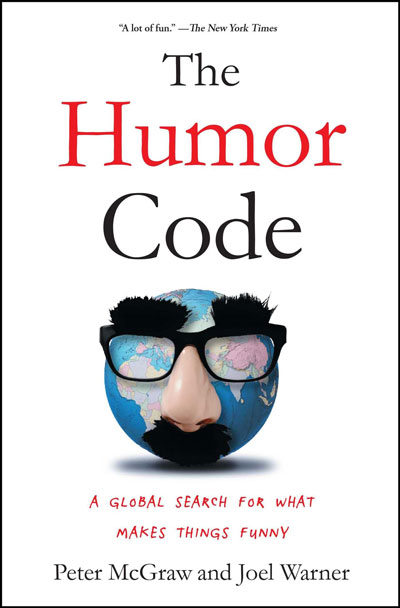The Humor Code a Global Search for What Makes Things Funny

The Humor Code: A Global Search for What Makes Things Funny
by Peter McGraw, Joel Warner
Published: April 1st 2014
Genres: Non-fiction
Format: eBook (239 pages)
Source: Purchased
Part road-trip comedy and part social science experiment, a scientist and a journalist detail their epic quest to discover the secret behind what makes things funny.
Two guys. 19 experiments. Five continents. 91,000 miles. And a book that will forever change the way you think about humor.
Part road-trip comedy and part social science experiment, a scientist and a journalist detail their epic quest to discover the secret behind what makes things funny.
Dr. Peter McGraw, founder of the Humor Research Lab at the University of Colorado Boulder, teamed up with journalist Joel Warner on a far-reaching search for the secret behind humor. Their journey spanned the globe, from New York to Japan, from Palestine to the Amazon. Meanwhile, the duo conducted their own humor experiments along the way—to wince-worthy, hilarious, and illuminating results.
In their quixotic search, they questioned countless experts, from comedians like Louis C.K. to rat-tickling researchers, and answered pressing (and not-so-pressing) questions such as, "What's the secret to winning The New Yorker cartoon caption contest?"; "Who has the bigger funny bone—men or women, Democrats or Republicans?"; and "Is laughter really the best medicine?" As a final test, McGraw uses everything they learned to attempt stand-up—at the largest comedy festival in the world.
Funny, surprising, and often touching, The Humor Code is a revealing exploration of humor, society, and an unusual friendship.
The theory behind The Humor Code is that benign "moral violations" are funny. The example that he gave that set the author off on his research was about a church giving away a hummer which made the class he was teaching laugh. The example was supposed to cause disgust so one student asked why they were laughing instead. He didn't know and now we have this book where you can fall asleep — I mean find out. Because as interesting as the ideas and travel stories are, I've never read such a dry and boring book about humor.
Right from the introduction, the author mentions books that came before him to explore humor. One that he mentions is called "Leviathan or Matter, Forme, and Power of a Common-Wealth Ecclesiasticall and Civil" that was published in 1651. We must have very different definitions on what humor is because that book sounds dull. Later in the book he even says that "Nobody liked [Peter Sellers] anywhere (pg 98)." Aw sad :( I liked Peter Sellers. Even though I didn't find this book funny at all, there are some things I liked about The Humor Code.
After getting tired of reading so much about humor but not laughing, I would get on YouTube after reading a chapter and try to apply his theory of benign violation to stand-up comedians. It's definitely a new way to see humor that I hadn't thought about before. The definition of the benign violation theory is "when something seems wrong, unsettling or threatening (i.e., a violation), but simultaneously seems okay, acceptable, or safe (i.e., benign). (pg 9)" He gives two strategies for applying this kind of humor. The first one is the Sarah Silverman strategy which makes shocking things like AIDS seem more harmless. The second on is the Seinfeld strategy which points out what is wrong with everyday things that we've accepted as harmless. Sometimes I could see this strategy in the YouTube videos I watched and sometimes I couldn't. Either way, I enjoyed being a little more analytical of why things are funny.
Writing humor is odd. Comedians work really hard to get a subconscious response from people. The author describes writing humor as "if the point of the Sistine Chapel ceiling were to get the Pope to sneeze. (pg 42)" Not an example I would have used, but ok. Point taken.
Here are some vague and random tips on how to be funny:
- Fuse two frames of reference that have nothing to do with each other
- Be clever so you can have lots of frames of reference to work with
I found the chapters on the dark side of humor and the ability of humor to undermine power structures really interesting. I was disappointed in the chapter about Japanese humor which explained absolutely nothing about it other than it's the kind of humor you have to be there to get. The author really didn't need an entire long and tedious chapter to tell us that. I also didn't see the point of the extremely awkward and short interview with Louis CK. And the chapter about finding the laughing disease in Africa that they never actually found made my entire book club mad. The consensus from my book club was that it would have made a great TED talk or podcast episode but it was pretty boring as a book.
If you do decide to read The Humor Code, here are some of the YouTube videos I watched when I took a humor break. (Direct links below in case embedded ones don't work)
Every Couple Has a Hyper One, and a Chilled One…
James Veitch Is A Terrible Roommate – CONAN on TBS
Taylor Tomlinson On Growing Up Religious & Abstinent – CONAN on TBS
Book Review of The Humor Code on a Post-it
I post reviews like this on Instagram. Be sure to follow me there!

Save Save Save Save
Source: https://booksatruestory.com/2018/04/04/book-review-humor-code-peter-mcgraw-joel-warner/


0 Response to "The Humor Code a Global Search for What Makes Things Funny"
Post a Comment